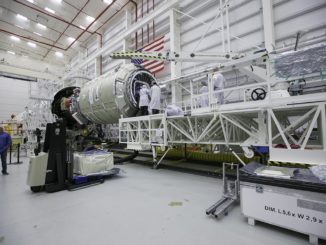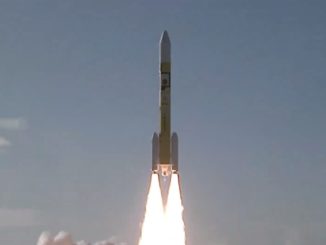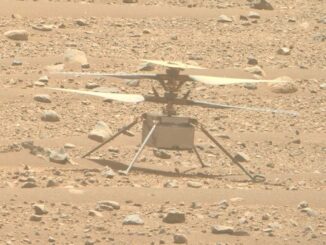
NASA’s Opportunity rover, now showing nearly 28 miles (45 kilometers) on its odometer since landing on Mars, recorded a panoramic view last month of its next scientific destination, a valley that may have been carved by water, an icy or muddy debris flow, or ancient Martian winds.
Imagery experts stitched together this view from a series of images taken by Opportunity’s panoramic camera from June 7 to June 19, according to NASA. The panorama covers three-quarters of a full-circle view.
The rover collected images for the panorama while engineers analyzed a stall on the robot’s left-front wheel steering actuator.
“The wheel was pointed outward more than 30 degrees, prompting the team to call the resulting vista Pancam’s ‘Sprained Ankle’ panorama,” NASA said in a press release.
Engineers were able to get the wheel pointed straight ahead to resume driving, but Opportunity now uses the steering capability of only its two rear wheels, NASA said. The right-front steering actuator failed in 2006.
Opportunity’s tracks lead into notch to the right of an outcrop dubbed “Cape Tribulation,” and scientists think the dip may have been a spillway through which water, ice or wind flowed into the bed of Endeavour Crater, an expansive 14-mile-wide (22-kilometer) depression the rover has explored for nearly six years.
The mobile robot landed on Mars in January 2004 and studied several smaller craters to find evidence that Mars was once habitable. Opportunity arrived at the rim of Endeavour Crater in 2011 after a cross-country journey from its original landing site, outliving its original three-month design life more than 50 times.
The floor of Endeavour Crater stretches toward the horizon in this panorama.
The wheel tracks visible in the image were created as Opportunity drove to the edge of the crater to look into “Perseverance Valley,” which lies on the inner slope of the crater rim just beyond the notch. Three-dimensional stereo images will help controllers plot Opportunity’s drive into the valley, which sits at a slope of 15 to 17 degrees and extends the length of two football fields, based on observations from orbit.
“It is a tantalizing scene,” said Ray Arvidson, Opportunity’s deputy principal investigator from Washington University in St. Louis. “You can see what appear to be channels lined by boulders, and the putative spillway at the top of Perseverance Valley. We have not ruled out any of the possibilities of water, ice or wind being responsible.”

The rover is now parked in the upper reaches of the valley.
Opportunity will drive deeper into Perseverance Valley next month once engineers re-establish full communications with the rover. Signals between Earth and spacecraft at Mars are currently blocked as the red planet travels behind the sun, but the rover is collecting a new panorama from its current location.
The valley is the prime target for this phase of Opportunity’s mission, which NASA approved last year through at least September 2018. Scientists want to know what created the valley, which is the first such fluid-carved feature to ever be visited by a rover on Mars.
Opportunity will also take measurements of the rocks inside Endeavour Crater to compare their composition to the material on the plains outside the crater, officials said.
Email the author.
Follow Stephen Clark on Twitter: @StephenClark1.



